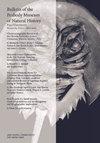线上的一个结:一个独特的侧线特性是否真的表征了Malaŵi湖巨大的单氯胺物种群(Teleostei:慈鲷科)?
IF 0.9
4区 哲学
Q2 BIODIVERSITY CONSERVATION
引用次数: 4
摘要
在上侧线的后端,一个或多个鳞片的长度向下弯曲,在它和下侧线之间只留下一排鳞片,而不是两排鳞片,被认为是将Malaŵi湖特有的单色胺稚鱼的两个分支的所有成员统一为一个单系群的突触形态。本文通过调查Malaŵi haplochromine (Pseudocrenilabrinae亚科Haplochromini部落)所有属代表的特征来验证这一说法。在大多数属中,扭结的存在是可变的,并且在两个(Abactochromis, Cyrtocara)中根本没有记录。没有扭结的标本发生在许多属中,扭结的存在和长度经常在身体的两侧变化。因此,很难证明这种扭结是物种群的突触性。这两个分支在扭结频率上不同;在非鼻翼支系中,79%的双侧可评估标本至少有一侧发生扭结,而在鼻翼支系中,这一比例仅为53% (p < 0.0001)。当存在扭结时,其长度在非鳞片(1至8鳞片,模式2)中比在鳞片(1至4鳞片,模式1)中变化更大。上侧线从上侧翼向后延伸,靠近或进入尾柄,那里没有鳞片排位于背侧,被认为是扭结存在的一个原因;可能还有其他因素有待发现。与已发表的声明相反,这种结在一些Astatotilapia calliptera的标本中表达。Astatotilapia calliptera是在Malaŵi湖和其他地方发现的一种重要的非地方性单氯胺,可能是该湖特有种群的姐妹。一个明显相同的横向结偶偶出现在其他湖泊和其他三个假crenilabrine鲷鱼部落的成员中,进一步驳斥了这一特征是Malaŵi湖物种群的突触性的假设。本文章由计算机程序翻译,如有差异,请以英文原文为准。
A Kink in the Line: Does a Unique Lateral-Line Peculiarity Really Characterize Lake Malaŵi's Huge Haplochromine Species Flock (Teleostei: Cichlidae)?
Abstract A downward kink one or more scales in length at the posterior end of the upper lateral line, leaving only one scale row instead of two between it and the lower lateral line, has been considered a synapomorphy uniting as a monophyletic group all members of both clades of endemic haplochromine cichlids of Lake Malaŵi. Here, this claim is tested by surveying the character in representatives of all genera of Lake Malaŵi haplochromines (tribe Haplochromini of the subfamily Pseudocrenilabrinae). Presence of the kink is shown to be variable in most genera, and it was not documented at all in two (Abactochromis, Cyrtocara). Specimens with no kink occur in many genera, and kink presence and length frequently vary on the two sides of the body. Thus, it is difficult to justify the kink as a synapomorphy of the species flock. The two clades differ in kink frequency; a kink occurred on at least one side of the body in 79% of bilaterally assessable specimens in the non-mbuna clade, but in only 53% of those in the mbuna clade (p < 0.0001). When a kink is present, its length is more variable in non-mbuna (1 to 8 scales, mode 2) than mbuna (1 to 4 scales, mode 1). Extension of the upper lateral line backward from the upper flank close to or onto the caudal peduncle, where no scale row is as dorsally situated, is identified as one cause of kink existence; additional factors likely await discovery. Contrary to published statements, the kink is expressed in some specimens of Astatotilapia calliptera, a phylogenetically important nonendemic haplochromine found in Lake Malaŵi and elsewhere, which may be the sister of the lake's endemic flock. An apparently identical lateral-line kink occurs sporadically in haplochromines in other lakes and in members of three other pseudocrenilabrine cichlid tribes, further refuting the hypothesis that this character is a synapomorphy of the Lake Malaŵi species flock.
求助全文
通过发布文献求助,成功后即可免费获取论文全文。
去求助
来源期刊

Bulletin of the Peabody Museum of Natural History
BIODIVERSITY CONSERVATION-ECOLOGY
CiteScore
2.40
自引率
0.00%
发文量
6
审稿时长
>12 weeks
期刊介绍:
The Bulletin of the Peabody Museum of Natural History publishes original research based on specimens, artifacts and related materials maintained in the collections of the Yale Peabody Museum of Natural History’s curatorial divisions. The Bulletin is published twice a year, in April and October.
 求助内容:
求助内容: 应助结果提醒方式:
应助结果提醒方式:


